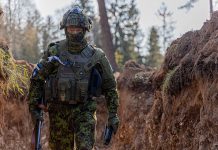The mushroom cloud that rose above the city of Beirut earlier this month bore the telltale colour and smell of ammonium nitrate, a substance with a long history of accidental and intentional destruction.
Synthetic ammonium nitrate (NH4NO3) was invented in 1909 by Polish-German chemist Fritz Haber, who was awarded the 1918 Nobel Prize in Chemistry for his work on the Haber-Bosch Process (the production of synthetic ammonia from nitrogen and hydrogen). Ammonium nitrate offered an industrially produced alternative to the limited quantities of naturally occurring sodium nitrate, a popular agricultural fertiliser of the time. The production of synthetic nitrogen fertilisers significantly increased crop yields, far beyond what had been achievable with naturally occurring fertilisers.
Ammonium nitrate is a white, odourless, crystalline nitrate salt, composed of ammonium and nitrate ions, and is still most commonly used as an agricultural fertiliser. Indeed, a significant portion of the world’s food supply relies on nitrate-based fertilisers to enhance growth. It is also used in some instant ice packs, as it is endothermic when dissolved in water and, importantly in light of recent events, in the construction and mining industries as a relatively cheap explosive material when mixed with other substances.
Ammonium nitrate can detonate through two transitions: deflagration to detonation, where a fire ignites a mass of ammonium nitrate, or where ammonium nitrate mixes with a combustible material during a fire, as most recently seen, with catastrophic results, in Beirut. The other is shock-to-detonation, where an explosive charge in contact with a quantity of ammonium nitrate is initiated in order to cause a larger detonation.
However, ammonium nitrate is not an explosive by itself. When stored correctly, and without exposure to high heat, it is fairly difficult to ignite; but if a significant quantity of material is stored incorrectly for a long period of time, it begins to aggregate, absorbing moisture from the environment and becoming solid. This makes the substance more dangerous, as solidified ammonium nitrate intensifies the chemical reaction when ignited.
When mixed with primary explosives, such as aluminum powder or fuel oil, it acts as a powerful oxidiser that intensifies combustion and enables other materials to ignite.
The potent combination of ammonium nitrate and fuel oil (ANFO) has given the substance its notoriety as a terrorist ingredient of choice. ANFO was a choice explosive for PIRA, with ammonium nitrate fertilizer ubiquitous in the rural regions of the province, particularly after restrictions and tracing measures were imposed on other conventional explosives, such as gelignite. ANFO was used extensively in bombings both big and small, rural and urban, throughout the province, and also in bombings in the UK mainland. The Baltic Exchange, Bishopsgate, Docklands, and Manchester City bombings in the 1990s all involved large (1 tonne) ANFO bombs.
Whilst red plumed clouds and the acrid smell of ammonium nitrate are redolent of the Troubles, PIRA were in no way exclusive in the use of ANFO for improvised explosive devices. Timothy McVeigh used ANFO in the Oklahoma City bombings of 1995. The attack destroyed a federal office building in Oklahoma City, killing 169 people. In Afghanistan and Pakistan, the Taliban made use of ANFO, widely available from the agricultural sector.
Not all ammonium nitrate explosions have been intentional or nefarious. Throughout the First World War, there were numerous ammonium nitrate-based explosions at munitions factories in Belgium, the UK and the United States. In 1921, a chemical plant in Oppau, Germany, exploded, killing 581 people and injuring thousands of others. In April 1947, a fire onboard the SS Grandcamp, docked in the Port of Texas City, Galveston Bay, detonated her cargo of 2300 tons of ammonium nitrate. The explosion started a chain of explosions and fires in neighbouring ships, port facilities and oil storage tanks. The resulting conflagration killed 581 people and is considered the worst industrial disaster in American history. That year was a notable one for ammonium nitrate disasters, as just three months after the Grandcamp explosion, the Norwegian vessel Ocean Liberty, carrying ammonium nitrate and other flammable materials, caught fire in Brest Harbour. The resulting explosion killed 29 and severely damaged the port of Brest. That same summer, two other fertilizer plants, one in Maine and the other in New Brunswick, were also consumed by ammonium nitrate-accelerated fires.
Over the next sixty years, there were numerous devastating industrial accidents involving ammonium nitrate all around the world. In Australia, Papua New Guinea, France, the United States, Spain and North Korea, incidents have evidenced the risks of poor storage practices, or exposure to heat and combustible materials.
These kinds of industrial accidents are in not events of a distant, less regulated past, or merely the preserve of hermit kingdoms. In 2013 a fertiliser plant in West, Texas, caught fire, creating an explosion that flattened a school, nearly 100 homes, and a care home facility. 15 people were killed and 200 injured in the blast. Five years ago, nitrocellulose stored at a facility in Tianjin, China, spontaneously combusted, causing a fire that detonated 800 tons of ammonium nitrate stored in a warehouse nearby. 1555 people were killed and nearly 800 injured, whilst the port of Tianjin was severely damaged.
Efforts have been made to mitigate the potential dangers of the substance. In the European Union, calcium must to be added to ammonium nitrate to create calcium ammonium nitrate, a more stable chemical compound. In the United States, facilities storing more than 900 kg of the material are subject to inspection by the Department of Homeland Security. Worldwide, guidelines exist for the safe handling, storage and transport of ammonium nitrate to reduce the risk of accidental catastrophic detonation.
Regulations, inspections and chemical additives are effective ways of reducing the potential dangers of ammonium nitrate. But, as the devastating explosion in Beirut demonstrated, they only work when enforced by authorities and adhered to by industry and individuals. So much for the chemistry behind Beirut’s recent disaster; but as is so often the case, life is more often about effects than it is about causes. We may not ever know the precise cause of the shocking detonation, but the immediate effects on the people of Beirut have been catastrophic, and the true aftershocks of the explosion may well be felt for some time as the Lebanese political establishment comes under increasing pressure, the people of Beirut continue to protest in the streets (streets that for so many are now also their homes), and the fragile balance of relative peace in this troubled country wobbles.







